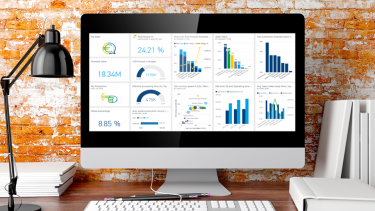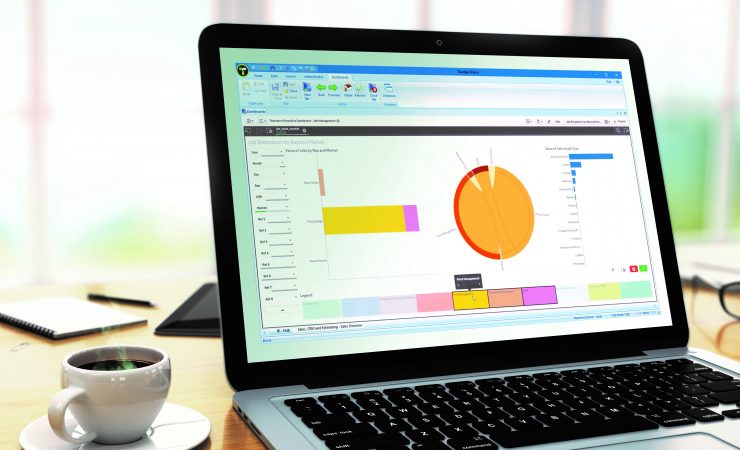Digital print produces production data continuously, and you can use it to run the business more efficiently by seeing the things that aren’t obvious from the production floor. Michael Walker looks at some of the options
For better or for worse, ‘Big Data’ and automated analytics are governing an increasing part of our lives, from suggesting content on social media to considering our suitability for various types of insurance or even employment. However, there are more benign uses in print, where the stream of information generated by productions system can be pooled, analysed and used to provide insights into business efficiency, known as business intelligence (BI), as well as providing an at-a-glance overview of how the enterprise is running.
This extends beyond just spotting which machines are persistently unreliable or which operators need better training within a business, and which jobs – or clients – are unprofitable, to crunching multiple users’ data collected worldwide to produce a repository of knowledge, advice and even predictions that all users can share. Increasingly, these capabilities are being built into Cloud-based platforms with access sold on a subscription basis, but there are other options. We discuss some of them here and look at one user’s experience.
Heidelberg – global aspirations
Heidelberg offers BI capabilities at two levels, according to Jacob Hededam, head of software sales and service, Northern Europe. The first is Prinect Smart BI, part of the Smart Printshop software suite, which is for what he terms ‘local’, on-premise capabilities that can be used to drive internal optimisation for training, equipment selection and identification of profitable customer groups or product types.

Heidelberg’s Prinect Smart BI provides a dashboard for factory performance
‘It monitors every step, from estimation and production scheduling through CtP, press and post-press. Cost and time information allows the business to be driven by KPIs [key performance indicators],’ he explains. He’s also adamant that every printshop should have this capability. ‘Can you spot the trends, how and when to make decisions? It’s a black and white choice these days – either drive productivity and optimise the business or be purchased or gone. Those who have understood will have free capacity to sell,’ he suggests, explaining that for litho printers, getting 18,000 impressions an hour instead of 12,000 increases real-world capacity; he argues that the principle applies to digital printers too, perhaps even more so, as a key aspect is handling the admin functions around each job, and there are generally more jobs in digital print.
Some of the automation capability comes from data that Heidelberg has been collecting since 2008 (though digital press data has only been accumulating for three or four years so far), with over 15,000 printshops worldwide connected into its private cloud. ‘We know a lot about how to produce different products,’ says Mr Hededam, adding that this body of data can be used to benefit users who haven’t necessarily contributed to it.
All of this is leading to the second level of capability, which is currently dubbed ‘Prinect Cloud’. This will among other things be able to automate decisions about whether to print jobs litho or digital and to handle the necessary colour management and other job parameters and processes. He’s bullish that the system will make better decisions than humans, too. ‘We often don’t utilise the tools that are available because we think we can do better. I’m very sorry, but we’re wrong.’
Mr Hededam describes the new development, which will be properly unveiled at Drupa 2020, as an ‘ecosystem for the industry’ in which the current software modules will be replaced by application-specific ‘functions’ such as labels, packaging or commercial print, from which customers can choose, with the option to turn the software subscription or off as required.
‘It will be open to others via an API so everyone can develop for the ecosystem,’ says Mr Hededam, adding that Heidelberg will be inviting UK MIS developers to create tools to work with it. The new platform will ‘look like Apple’s AppStore or Google Play’ where users purchase modules to combine into their own workflows, guided by data-based recommendations. ‘We will create an industry Cloud – others have done islands, but no one has created a standard for print,’ claims Mr Hededam.
Kodak Prinergy – cloud-based analytics
The Decision Analytics Dashboard is part of Kodak’s new Prinergy Cloud services, available to users of its digital presses, CtP and other analogue print devices and software. It is intended to help users turn the print production data that it gathers into ‘actionable analysis and insightful reporting’, according to Stephen Miller, director of product management in Kodak’s software division. Mr Miller says that the decision to develop this was in response to customer needs: ‘Our customers needed solutions to wade through large amounts of system / log data that Prinergy and other manufacturing products produce – on a continuous basis. The benefits from using data analytics in a day-to-day manufacturing operation, allow for informed production decisions to be made which drive out waste and improve efficiency.’
The software can connect to third-party MIS and to RIPs/DFEs to collect production information in real time. It allows users to look ahead to see the impact of future consumables usage and costs, while also enabling retrospective analysis to understand the effect of seasonal trends, software and hardware performance and workflow inefficiencies. Looking to Prinergy Cloud’s own future, having overcome the challenges of building a platform capable of ingesting and analysing continuous streams of data from thousands of customers around the world, Mr Miller comments, ‘A logical extension of any analytics and business intelligence platform is the use of AI or machine learning algorithms to help users quickly identify repeating patterns or outcomes, and make a prediction or take a proposed recommendation or course of action.’
Tharstern – open to all
UK MIS developer Tharstern offers a number of routes to adding BI capabilities. There is a specific BI tool that it offers in addition to its core MIS, which means that there is now a ‘BI layer’ to the latter. In conjunction with the core product’s open SQL database, this makes it also possible to integrate with third-party BI tools so that Tharstern users have a wider choice that just the developer’s own offering.

Tharstern’s Lee Ward says Excel is still popular in smaller organisations
Tharstern sales director Lee Ward says, ‘Access to Business Intelligence is a crucial part of running any successful business, it’s needed to identify trends and relationships. A BI tool allows a business to drill down into the figures and further investigate how to improve. Some Tharstern customers have used the open SQL to achieve some amazing ways to consume MIS information and create actionable analytics for key decision makers.’
Mr Ward added that Microsoft Excel remains a ‘firm favourite’ with some Tharstern users, particularly in smaller businesses. ‘It’s a basic, cost effective program to use and can be easily connected to Tharstern via an ODBC connection,’ he states, adding that Microsoft Power BI is a ‘cost-effective tool which is part of the Office 365 subscription and can be used to present data from the Tharstern database’. For those who prefer to keep everything within one software environment Tharstern offers Qlik, Crystal Reports and Dashboard (MiView).
The EFI Pace user’s experience
GPS Colour is the oldest print company in Ireland and was the first to go digital, though litho remains core to the business, according to director David Bell. In 2017 a move to larger premises allowed the creation of a purpose-built digital print environment for both large and small format work, that was duly populated by a Xerox iGen 5 and a Mimaki poster printer. However, the Prism MIS used by GPS Colour didn’t adapt so well to digital print. ‘It didn’t cope well with digital and litho in one system – it could do one or the other but not both,’ recalls Mr Bell.
Prism had been acquired by EFI some years earlier, and support continued, so it was natural to see if there was a better offering. The answer was the Pace MIS, which Mr Bell describes as a ‘revelation’, though the configuration process has taken some time – the software was installed in April 2018 but the system went live for digital work in the early summer of 2019.
‘It does digital and litho plus wide-format all in one place,’ he confirms, noting that the system easily handles additional requests like single digitally printed posters or banners on top of large run litho jobs.
Perhaps just as valuable is the reporting from Pace. ‘We can see what’s going on – costs and margins by customer or type of job; we really see what areas are making or losing money and what sectors we can target, such as wiro-bound jobs,’ reports Mr Bell.
Initial staff reluctance to learn the new system has faded as its benefits have become more apparent. ‘The digital press operators love it, the dockets tell them what to do and the Fiery RIP in the iGen means we get real, accurate feedback instantaneously,’ reports Mr Bell. Data is also collected from litho presses, the finishing department and to a lesser degree of detail, the wide-format department.
Even after a relatively short period of use, the Pace system has provided some unexpected insights, such as persistent under-estimating for the time that drilling takes, based on a an outdated note. Apart from that it’s ‘nothing that we hadn’t already suspected but it lets us put a finger on it,’ says Mr Bell. The information coming from the system via the reports will be used to drive further efficiencies and to identify less profitable work.
This sampling of vendors is by no means exhaustive, but provides an indication of what is already possible or coming soon in a rapidly-developing area of workflow and business management. We expect to see a lot more of this at Drupa 2020.





